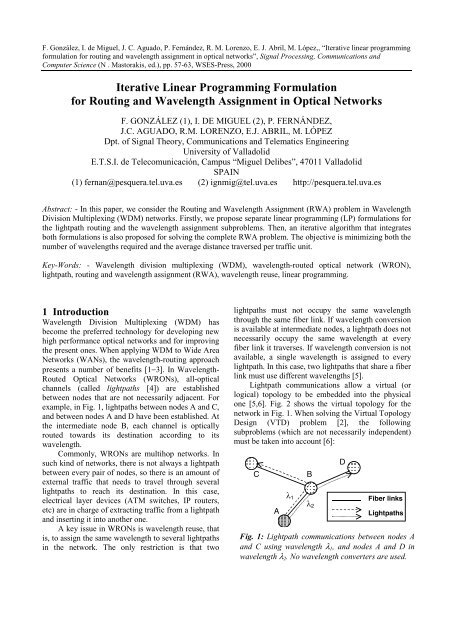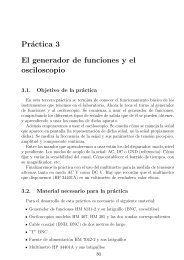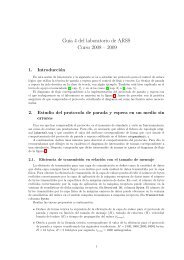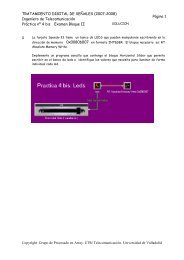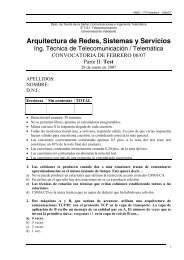Iterative Linear Programming Formulation for Routing and ...
Iterative Linear Programming Formulation for Routing and ...
Iterative Linear Programming Formulation for Routing and ...
Create successful ePaper yourself
Turn your PDF publications into a flip-book with our unique Google optimized e-Paper software.
F. González, I. de Miguel, J. C. Aguado, P. Fernández, R. M. Lorenzo, E. J. Abril, M. López,, “<strong>Iterative</strong> linear programming<strong>for</strong>mulation <strong>for</strong> routing <strong>and</strong> wavelength assignment in optical networks”, Signal Processing, Communications <strong>and</strong>Computer Science (N . Mastorakis, ed.), pp. 57-63, WSES-Press, 2000<strong>Iterative</strong> <strong>Linear</strong> <strong>Programming</strong> <strong>Formulation</strong><strong>for</strong> <strong>Routing</strong> <strong>and</strong> Wavelength Assignment in Optical NetworksF. GONZÁLEZ (1), I. DE MIGUEL (2), P. FERNÁNDEZ,J.C. AGUADO, R.M. LORENZO, E.J. ABRIL, M. LÓPEZDpt. of Signal Theory, Communications <strong>and</strong> Telematics EngineeringUniversity of ValladolidE.T.S.I. de Telecomunicación, Campus “Miguel Delibes”, 47011 ValladolidSPAIN(1) fernan@pesquera.tel.uva.es (2) ignmig@tel.uva.es http://pesquera.tel.uva.esAbstract: - In this paper, we consider the <strong>Routing</strong> <strong>and</strong> Wavelength Assignment (RWA) problem in WavelengthDivision Multiplexing (WDM) networks. Firstly, we propose separate linear programming (LP) <strong>for</strong>mulations <strong>for</strong>the lightpath routing <strong>and</strong> the wavelength assignment subproblems. Then, an iterative algorithm that integratesboth <strong>for</strong>mulations is also proposed <strong>for</strong> solving the complete RWA problem. The objective is minimizing both thenumber of wavelengths required <strong>and</strong> the average distance traversed per traffic unit.Key-Words: - Wavelength division multiplexing (WDM), wavelength-routed optical network (WRON),lightpath, routing <strong>and</strong> wavelength assignment (RWA), wavelength reuse, linear programming.1 IntroductionWavelength Division Multiplexing (WDM) hasbecome the preferred technology <strong>for</strong> developing newhigh per<strong>for</strong>mance optical networks <strong>and</strong> <strong>for</strong> improvingthe present ones. When applying WDM to Wide AreaNetworks (WANs), the wavelength-routing approachpresents a number of benefits [1−3]. In Wavelength-Routed Optical Networks (WRONs), all-opticalchannels (called lightpaths [4]) are establishedbetween nodes that are not necessarily adjacent. Forexample, in Fig. 1, lightpaths between nodes A <strong>and</strong> C,<strong>and</strong> between nodes A <strong>and</strong> D have been established. Atthe intermediate node B, each channel is opticallyrouted towards its destination according to itswavelength.Commonly, WRONs are multihop networks. Insuch kind of networks, there is not always a lightpathbetween every pair of nodes, so there is an amount ofexternal traffic that needs to travel through severallightpaths to reach its destination. In this case,electrical layer devices (ATM switches, IP routers,etc) are in charge of extracting traffic from a lightpath<strong>and</strong> inserting it into another one.A key issue in WRONs is wavelength reuse, thatis, to assign the same wavelength to several lightpathsin the network. The only restriction is that twolightpaths must not occupy the same wavelengththrough the same fiber link. If wavelength conversionis available at intermediate nodes, a lightpath does notnecessarily occupy the same wavelength at everyfiber link it traverses. If wavelength conversion is notavailable, a single wavelength is assigned to everylightpath. In this case, two lightpaths that share a fiberlink must use different wavelengths [5].Lightpath communications allow a virtual (orlogical) topology to be embedded into the physicalone [5,6]. Fig. 2 shows the virtual topology <strong>for</strong> thenetwork in Fig. 1. When solving the Virtual TopologyDesign (VTD) problem [2], the followingsubproblems (which are not necessarily independent)must be taken into account [6]:CABDλ 1λ 2Fiber linksLightpathsFig. 1: Lightpath communications between nodes A<strong>and</strong> C using wavelength λ 1 , <strong>and</strong> nodes A <strong>and</strong> D inwavelength λ 2 . No wavelength converters are used.
.CADLogical LinksFig. 2: Logical topology embedded in Fig.1.i) Determine a good virtual topology, that is, theorigin <strong>and</strong> destination node of every lightpath.ii) Route the lightpaths over the physicaltopology.iii) Assign wavelengths to the lightpaths.iv) Route the externally offered traffic on thevirtual topology.In this study, we center in subproblems ii) <strong>and</strong>iii), which are known in joint as the <strong>Routing</strong> <strong>and</strong>Wavelength Assignment (RWA) problem. It can bedefined as follows [2]: Given a network topology <strong>and</strong>a set of lightpath requests, determine a route <strong>and</strong>wavelength(s) <strong>for</strong> the requests. Some parameters to beoptimized when solving the RWA problem are thenumber of wavelengths needed, the wavelength reuse,the physical distance traversed by the traffic, <strong>and</strong> thecost.We propose two separate <strong>for</strong>mulations to solvethe RWA problem when there is no wavelengthconversion. The <strong>for</strong>mer routes the lightpaths in a waythat the average distance traversed per traffic unit isminimized. Besides, it limits the number of lightpathsper fiber link (which is a heuristic <strong>for</strong> limiting thenumber of wavelengths needed). The latter assignswavelengths to the lightpaths once they have beenrouted. In this case, the objective is to maximize thewavelength reuse. We also propose an iterativealgorithm to solve the RWA problem by combiningboth <strong>for</strong>mulations. Finally, a number of results areshowed.The lightpaths are routed using a shortest-pathalgorithm. Then, wavelengths are assigned to thoselightpaths with a large traffic load first.The routing problem is also solved by means of ashortest-path algorithm in [8], but wavelengths areassigned sequentially beginning with the longestlightpath.In [9], subproblem ii) is <strong>for</strong>mulated as an integerlinear programming (ILP) problem. Severaltechniques, as r<strong>and</strong>omized rounding, are employed toreduce the problem complexity. To solve subproblemiii), graph-coloring algorithms are used.A mixed integer linear programming (MILP)<strong>for</strong>mulation <strong>for</strong> subproblems i) <strong>and</strong> ii), as well as anumber of heuristics <strong>for</strong> solving subproblem i) injoint with the RWA problem are proposed in [5].In [10], an ILP <strong>for</strong>mulation <strong>and</strong> two heuristics(based on Dijkstra’s algorithm) are proposed <strong>for</strong>solving RWA. One of them routes lightpathssequentially. The other one routes them in parallel.Both take into account the available wavelengths <strong>and</strong>their capacity at every fiber link. A cost model isstated to compute the distance used by the shortestpathalgorithm. Finally, an improvement step is run.A genetic-algorithm/heuristic hybrid approach isproposed in [11] <strong>for</strong> solving RWA with the objectiveof minimizing the cost of the network.3 <strong>Routing</strong> <strong>and</strong> Wavelength AssignmentAs stated be<strong>for</strong>e, the RWA problem consists inrouting the lightpaths through the physical topology<strong>and</strong> assigning wavelengths to them. We suppose thereis no wavelength conversion, so each lightpath isassigned a single wavelength. In the next paragraphs,we propose new separate ILP <strong>for</strong>mulations <strong>for</strong> solvingsubproblems ii) <strong>and</strong> iii). By separating RWA intosubproblems the total computational cost is reduced.2 Previous WorkIn the last years, several papers about virtualtopology design have been published [4−17]. Next,we will overview some of them concerning therouting <strong>and</strong>/or the wavelength assignment problem.The work in [4] proposes to allocate thewavelengths to the longest lightpaths first, as aheuristic <strong>for</strong> minimizing the number of wavelengthsneeded when solving subproblem iii).In [7], subproblems i), ii) <strong>and</strong> iii) are considered.3.1 The Lightpath <strong>Routing</strong> ProblemIn this problem, a route over the physical topology iscomputed <strong>for</strong> every lightpath. As proposed in [6] <strong>and</strong>[11], we use flow conservation equations at each nodeto properly route the lightpaths. Note that the numberof wavelengths that are needed <strong>for</strong> establishing thelightpaths, once they have been routed, depends onthe maximum number of lightpaths that share a singlefiber link (we call it ρ max ). In fact, ρ max will be a lowerbound on the number of wavelengths. In Fig. 1, the
.fiber link between A <strong>and</strong> B supports two lightpaths,so (at least) two different wavelengths λ 1 <strong>and</strong> λ 2 areneeded. As shown in Fig. 3, it is possible that thenumber of wavelengths needed exceeds ρ max . In thisfigure, every fiber link supports exactly twolightpaths, but a third wavelength is required to routethe one from B to C, given that λ 1 <strong>and</strong> λ 2 are beingused in the fiber links it traverses <strong>and</strong> there is not anywavelength converter.Consider an N-nodes network, with 2Eunidirectional links (E bidirectional fiber links)numbered as e = 1, ... , 2E. Let us denote by s(e) thesource node of physical link e, <strong>and</strong> by d(e) itsdestination node. Let w e be the physical distance oflink e.Consider H lightpath requests numbered as h = 1,... , H. Let us denote by s(h), the source node of thelightpath h, <strong>and</strong> by d(h) its destination node. Let f h bethe traffic to be routed over lightpath h.hhWe define the variables pe, with pe= 1 if thelightpath h traverses through the physical link e <strong>and</strong>hpe= 0 otherwise. Then, we can <strong>for</strong>mulate thelightpath routing problem as follows:1hMinimize ∑ ( f h δ )(1)f total hsubject to:hhδ = ∑ w p ∀ h(2)∑hpeed ( e)= nhpe'e's(e')= nh∑ pees(e)= s(h)h∑ peed ( e)= s(h)= ∑Beeeftotal= ∑ f h(3)h∀ h,n = 1, L , N : n ≠ s(h),d(h)(4)heed ( e)= d ( h)= 1; ∑ phees(e)= d ( h)= 0 ; ∑ p= 1= 0λ 1λ 2λ 3A∀ h∀ hFig. 3: Three wavelengths are needed althoughevery fiber link only supports two lightpaths.C(5)(6)h∑ pe ≤ M ∀ e(7)hWe have called this problem BWR (<strong>for</strong> Bounded-Wavelength <strong>Routing</strong>). Note that it is an integer linearhprogramming (ILP) problem. Equation (2) defines δas the total distance of the lightpath h. Equation (3)defines f total as the total traffic on the network.There<strong>for</strong>e, the objective function (1) minimizes theaverage distance per traffic unit. Equations (4)−(6)are flow conservation restrictions. By means ofequations (5) <strong>and</strong> (6), it is ensured that every lightpathstarts at its source node <strong>and</strong> finishes at its destinationnode. Equation (4) ensures that the lightpath follows acontinuous route from its source to its destination.The parameter M in (7) is an upper bound on thenumber of lightpaths supported by a single fiber link,<strong>and</strong> it must be introduced as a design parameter. Notethat, as shown in Fig. 3, it does not ensure that only Mdifferent wavelengths are needed. As it will be shownlater, BWR can be used in an iterative manner,beginning with an arbitrarily low value of M(obviously, greater or equal than one) <strong>and</strong> increasingit until a solution of BWR is feasible.Some variations can be applied to this<strong>for</strong>mulation. The objective function (1) supposes thetraffic flowing through every lightpath to be known orestimated. If it is not, the objective function ∑hcan be used. Then, the minimum total lightpath lengthis achieved. On the other h<strong>and</strong>, if we set w e = 1 ∀ e,the number of nodes crossed by lightpaths isminimized, which may be desirable <strong>for</strong> somenetworks. Furthermore, it is possible to model thenodes of the network like in [10] <strong>and</strong> [12] so that thenode utilization can also be optimized. Anothervariation is to minimize M instead of the averagedistance per traffic unit, which would achieve theminimum ρ max <strong>for</strong> a given network. In theexperiments that we have carried out, this variationresulted in an unacceptable increase of thecomputation time.3.2 The Wavelength Assignment ProblemOnce the lightpaths have been routed, a wavelengthmust be assigned to each one. In this section, we willpresent an ILP <strong>for</strong>mulation <strong>for</strong> the wavelengthassignment problem. We have called it MRA (<strong>for</strong>Maximum-Reuse wavelength Assignment). Suppose ahlightpath routing scheme, given by the pevariablesδh
.previously defined. Let µ be the number of availablehwavelengths. Let ck(h = 1, ... , H; k = 1, ... , µ) be thewavelength assignment variables, with c h k= 1 ifwavelength k is assigned to lightpath h, <strong>and</strong> c h k= 0otherwise. Then, MRA is <strong>for</strong>mulated as follows:k − 1 hH + 1 c(8)∑∑Minimize ( )khsubject to:h∑ c= ∀ h(9)kh h∑ pe ⋅ ck∀ k,e (10)hEquation (9) ensures that every lightpath isassigned a single wavelength. Equation (10) avoidsthat two lightpaths supported by the same fiber link eare assigned the same wavelength k. The objectivefunction (8) maximizes the wavelength reuse, that is,it assigns the same wavelength (those correspondingto the lowest values of k are preferred) wheneverpossible. Hence, some of the µ wavelengths can beunnecessary. Next, we will prove that (8) maximizesthe wavelength reuse. Note that the coefficient ofheach ckin (8) is (H + 1) k – 1 . Besides this, since atmost H different lightpaths can be assigned thehwavelength k, it is verified that ∑ c≤ H ∀ k .hThen,H +k − 1 hck+− 1H 1hc ≤∑ ( 1 )k= ( ) ∑hk 1≤ ( H + ) H < ( H 1) k1 −+ (11)(H + 1) k his the coefficient of ck+ 1∀ h, so (8) will belower if all the lightpaths in the network are assignedthe wavelength k than if a single lightpath is assignedthe wavelength k + 1.3.3 An <strong>Iterative</strong> Algorithm <strong>for</strong> RWA (IRWA)In this section we propose an iterative algorithm(called IRWA) that integrates BWR <strong>and</strong> MRA tosolve the RWA problem. The algorithm attempts tominimize the number of wavelengths needed to routea group of lightpath requests <strong>and</strong> to maximize thewavelength reuse. For a given network <strong>and</strong> <strong>for</strong> a setof lightpath requests, we denote by BWR(M) thesolution obtained when solving BWR <strong>for</strong> thatparticular value of M. If the solution is unfeasible,then BWR(M) = ∅. We also define MRA(R, µ) in thekhksame way, being R = { p h e} a lightpath routingscheme <strong>for</strong> the given requests.IRWA algorithm:Initialization: Let M be some lower bound onthe number of different wavelengths needed.If none is known, then M = 1.While BWR(M) = ∅ BeginM = M + 1End Whileµ = MR = BWR(M)While MRA(R, µ) = ∅ Beginµ = µ + 1End WhileSeveral authors have presented lower bounds onthe number of wavelengths <strong>for</strong> different networks[2,8]. Next, we present a simple lower bound <strong>for</strong>estimating the goodness of IRWA. Given an N-nodesnetwork with the same physical degree θ <strong>and</strong> thesame logical degree T on each node, at most N θlightpaths of one-hop length can be established(supposing that there is at most one lightpath <strong>for</strong> eachpair of nodes), N θ ( θ − 1)of two-hop length, <strong>and</strong> soon. Then, lightpaths of at least D hops must beestablished, being D an integer such as:D−2∑i=0iD−1Nθ ( θ −1)+ N'θ ( θ −1)= NT (12)where N ' is a real number such as 0 < N'≤ N .1(Notice that N'θ ( θ −1)D− is an integer numbermeaning the number of lightpaths of length D). Alightpath consists of a series of lightpath segmentsfrom its source to its destination (one segment <strong>for</strong>each fiber link it traverses). Then, the minimumnumber of lightpath segments in the network is:D−2S = ∑ ( i + 1) Ni=0iD−1θ ( θ −1)+ DN'θ ( θ −1)(13)If we suppose these segments are uni<strong>for</strong>mlydistributed among the 2E unidirectional physical links(i. e., each physical link supports the same number oflightpaths), then the minimum number of lightpathsegments per physical link (which is a lower boundon the number of wavelengths required) is:⎡ S ⎤µ min =(14)⎢2E⎥Note that this is an optimistic lower bound. For eachnode, we are supposing that lightpaths are established
.between its T nearest nodes, <strong>and</strong> that the number oflightpaths per link is the same <strong>for</strong> the entire network.Both assertions are unlikely <strong>for</strong> real networks, somore than µ min wavelengths will be needed in general.4 ResultsWe have used the algorithm explained above to solveRWA <strong>for</strong> a number of r<strong>and</strong>omly generated networks.We have used the lp_solve package [18] to solve LPproblems. Fig. 4 shows the number of wavelengthsthat were needed in 12-nodes networks, as a functionof the number of bidirectional fiber links E, <strong>for</strong>logical degree T = 5. The lower bound stated in (14)is also shown. We carried out 10 experiments <strong>for</strong> eachvalue of E. For choosing a virtual topology, r<strong>and</strong>omtraffic patterns have been generated <strong>for</strong> each network,<strong>and</strong> logical links have been established in a mannerthat the largest amount of traffic can be routed in onehop [2,5,13], which is a heuristic <strong>for</strong> minimizing thecongestion. Note that the results are slightly higherthan the lower bound.We have also applied the algorithm to theNFSnet [5,6], which is shown in Fig. 5. The resultsare presented in Fig. 6 together with the results from[5] (algorithms HLDA, TILDA <strong>and</strong> MLDA). Thejoint use of BWR <strong>and</strong> MRA (IRWA) results in bettervalues than HLDA, which chooses the virtualtopology by maximizing the traffic in one-hop, <strong>and</strong> insimilar values to those of TILDA <strong>and</strong> MLDA. Notethat the latter algorithms establish lightpaths betweenadjacent nodes (they do not consider the traffic asHLDA <strong>and</strong> IRWA do) so the number of wavelengthsrequired is expected to be low.Computation time is a key factor when choosingheuristic (sub-optimal) approaches instead of linearprogramming ones [2,5,6,9,10,13,16,17]. We haveFig. 5: The 14-nodes NFSnet backbone.executed the algorithm <strong>for</strong> series of five r<strong>and</strong>omgenerated networks with different number of nodes,<strong>and</strong> computed the mean time <strong>and</strong> the 95% confidenceinterval [19] that took to solve them. As shown in Fig.7, computation time presents an exponential growthwith the number of nodes, but it is smaller than thirtyseconds <strong>for</strong> 20-nodes networks. We consider this timeis good enough <strong>for</strong> the static approach (the one wehave followed in this paper), in which lightpathsrequests arrive simultaneously <strong>and</strong> they are routedoff-line.5 ConclusionIn this paper, separate ILP <strong>for</strong>mulations <strong>for</strong> routinglightpaths <strong>and</strong> assigning wavelengths to them havebeen proposed. The <strong>for</strong>mer limits the number oflightpaths per fiber link <strong>and</strong> minimizes the averagedistance traversed per traffic unit. The lattermaximizes wavelength reuse. We have also proposedan iterative algorithm <strong>for</strong> the joint use of bothmethods to solve the whole RWA problem. Thisalgorithm is computationally quite tractable <strong>and</strong>provides solutions where the number of wavelengthsrequired is close to the optimal one.Wavelengths1086420IRWALower bound20 24 27 30 33Bidirectional Physical LinksFig. 4: Number of wavelengths required <strong>for</strong>r<strong>and</strong>omly generated networks. Mode <strong>and</strong> intervalscontaining the whole of the results are showed.Wavelengths1210864202 3 4 5 6Logical DegreeHLDATILDAMLDAIRWAFig. 6: Number of wavelengths required <strong>for</strong> theNFSnet.
.Time (s)25201510508 10 12 14 16 18 20NodesFig. 7: Computation time of IRWA (Pentium II400 MHz, 128 MB RAM, Windows NT 4.0)References:[1] R. Ramaswami, Multiwavelength LightwaveNetworks <strong>for</strong> Computer Communication, IEEECommunications Magazine, Feb. 1993, pp. 78-88.[2] R. Ramaswami, K. Sivarajan, Optical Networks:A Practical Perspective. Morgan KaufmannPublishers, Inc., 1998.[3] O. Gerstel, On the Future of Wavelength <strong>Routing</strong>Networks, IEEE Network, Nov./Dec. 1996, pp.14-20.[4] I. Chlamtac, A. Ganz, G. Karmi, LightpathCommunications: An Approach to HighB<strong>and</strong>with Optical WAN’s, IEEE Transactions onCommunications, Vol. 40, No. 7, 1992, pp. 1171-1182.[5] R. Ramaswami, K. Sivarajan, Design of LogicalTopologies <strong>for</strong> Wavelength-Routed OpticalNetworks, IEEE Journal on Selected Areas inCommunications, Vol. 14, No. 5, 1996, pp. 840-851.[6] B. Mukherjee, D. Banerjee, S. Ramamurthy, A.Mukherjee, Some Principles <strong>for</strong> Designing aWide-Area WDM Optical Network. IEEE/ACMTransactions on Networking, Vol. 4, No. 5, 1996,pp. 684-696.[7] Z. Zhang, A.S. Acampora, A HeuristicWavelength Assignment Algorithm <strong>for</strong> MultihopWDM Networks with Wavelength <strong>Routing</strong> <strong>and</strong>Wavelength Re-Use, IEEE/ACM Transactions onNetworking, Vol. 3, No. 3, 1995, pp. 281-288.[8] S. Baroni, P. Bayvel, Wavelength Requirementsin Arbitrarily Connected Wavelength-RoutedOptical Networks, Journal of LightwaveTechnology, Vol. 15, No. 2, 1997, pp. 242-251.[9] D. Banerjee, B. Mukherjee, A Practical Approach<strong>for</strong> <strong>Routing</strong> <strong>and</strong> Wavelength Assignment in LargeWavelength-Routed Optical Networks. IEEEJournal on Selected Areas in Communications,Vol. 14, No. 5, 1996, pp. 903-908.[10] T. Cinkler, D. Marx, C. Larsen, D. Fogaras,Heuristic Algorithms <strong>for</strong> Joint Configuration ofthe Optical <strong>and</strong> Electrical Layer in Multi-HopWavelength <strong>Routing</strong> Networks. INFOCOM, TelAviv, Mar. 2000. Accessed in Jan. 2000 athttp://www.comnet.technion.ac.il/infocom2000[11] M.C. Sinclair, Minimum Cost Wavelength-Path<strong>Routing</strong> <strong>and</strong> Wavelength Allocation using aGenetic-Algorithm/Heuristic Hybrid Approach.IEE Proceedings in Communications, Vol. 146,No. 1, 1999, pp. 1-7.[12] T. Cinkler, R.S. Castro, S. Johansson,Configuration <strong>and</strong> Reconfiguration of WDMNetworks, in Technology <strong>and</strong> InfrastructureNOC’98-III, IOS Press, 1998.[13] J.-F.P. Labourdette, A.S. Acampora, LogicallyRearrangeable Multihop Lightwave Networks,IEEE Transactions on Communications, Vol. 39,No. 8, 1991, pp. 1223-1230.[14] I. Chlamtac, A. Ganz, G. Karmi, Lightnets:Topologies <strong>for</strong> High-Speed Optical Networks.Journal of Lightwave Technology, Vol. 11, No.5/6, 1993, pp. 951-961.[15] I. Chlamtac, A. Faragó, T. Zhang, Lightpath(Wavelength) <strong>Routing</strong> in Large WDM Networks.IEEE Journal on Selected Areas inCommunications, Vol. 14, No. 5, 1996, pp. 909-913.[16] S. Banerjee, J. Yoo, C. Chen, Design ofWavelength-Routed Optical Networks <strong>for</strong> PacketSwitched Traffic, Journal of LightwaveTechnology, Vol. 15, No. 9, 1997, pp. 1636-1646.[17] F. González, I. de Miguel, J.C. Aguado, P.Fernández, R.M. Lorenzo, E.J. Abril, M. López,An Algorithm to Design Logical Topologies inWavelength-Routed Optical Networks.Proceedings of the European Conference onNetworks <strong>and</strong> Optical Communications 2000(NOC 2000), Stuttgart, Germany, 6-9 June 2000.Accepted <strong>for</strong> publication.[18] M. Berkelaar <strong>and</strong> J. Dirks. Lp_solve: The mixedinteger linear program solver. Accessed in Feb.2000 at ftp://ftp.es.ele.tue.nl/pub/lp_solve/[19] A.M. Law, W.D. Kelton, Simulation Modeling &Analysis (2nd ed.), McGraw-Hill InternationalEditions, 1991.


